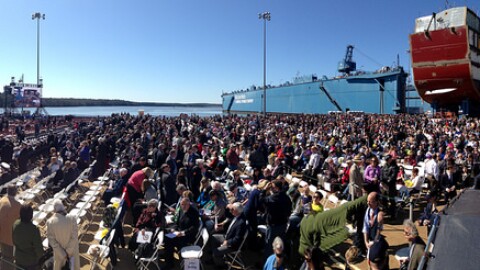A couple of weeks ago, the world's most advanced warship, the USS Zumwalt, formally hit the water at a christening ceremony at Bath Iron Works. The midcoast shipyard is due to build two more of the DDG-1000 destroyers for the U.S. Navy over the next several years. The program, however, has ended up being much more costly than originally intended, in part because it was drastically cut back a few years ago from 32 ships to just three.
The last data show costs increased again, by $2 billion over the last five years, $450 million of that in the last year alone. That's a nearly 20 percent increase, sending the total program cost to more than $12 billion.
 Sam LaGrone is an analyst with the U.S. Naval Institute in Washington, D.C.
Sam LaGrone is an analyst with the U.S. Naval Institute in Washington, D.C.
Credit Sam LaGrone
Analyst Sam LaGrone is with the U.S. Naval Institute in Washington DC. He's been crunching the numbers he spoke with MPBN about this issue.
Tom Porter: "What's going on here? How did this program get so costly?"
Sam LaGrone: "What's surprising about these figures is that the program was completely restructured back in 2010 when it did its last reduction, and that was supposed to set up a relatively stable baseline for cost. But a 20 percent cost increase for the entire ship program is a little startling when you look at it all at once."
TP: "So on top of the fact that it's more per ship because the program's been shrunk to three ships, that's going to drive up costs, what other factors are driving up costs, and what are the unanswered questions as far as you're concerned?"
SL: "There's a couple of things that could potentially drive up costs. It could be really pretty much anything, it could be cost of labor, cost of materials, it could be development of new systems. The problem that we're looking at right now is that we just really don't know. It's really unclear as to why these cost increases have happened. Secretary Stackley, who's in charge, essentially the Navy's chief ship builder, talked to us a little bit back in March and blamed sequestration, and also said that cost growth could be occuring, or will be occuring, because of the accelerated timelines. But as far as a level of specificity of whether this is labor or systems problems, or cost increases or material increases, the Navy hasn't been terribly forthcoming as to why these costs have increased, specifically $450 million in the last year, that's about the cost of one of the Navy's Littoral combat ships that they're currently building."
TP: "It's obviously a subject of interest to people in Maine, BIW is the state's single biggest employer. The two remaining Zumwalt-class ships are due to be built in Bath. What are the implications for the shipyard?"
SL: "The yard shouldn't even be affected very much by these kind of cost increases. I mean the program is pretty much well underway. But again, there's still so many unanswered questions as to why these costs have gone up on this, and time is going to tell on exactly how these are going to impact the service and the Navy, I mean anticipate that all of these 3 of these ships are going to get built. "
TP: "We're at $12 billion now, for the program, two more ships to be built. Would you bet on it staying within the 12 billion figure?"
SL: "Who knows? I mean that's the problem, there's so many unanswered questions and cost growth in ship-building can be pretty standard, pretty normal, especially for a new type of ships, and especially for a class of ship that's so different and so full of technical advancements like the Zumwalt class. So I mean there can be all manner of unforeseen cost increases or manufacturing problems, or difficulties, or challenges I mean it doesn't necessarily have to be a problem with the way things are done, it's just figuring how to do it, and figuring out how those ships can be assembled and how they work. I mean that can be expensive."
Sam LaGrone is an analyst with the U.S. Naval Institute in Washington, D.C.
View the U.S. Naval Institute report.



